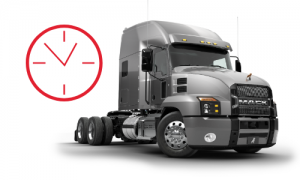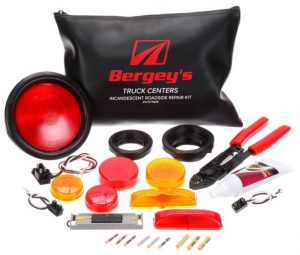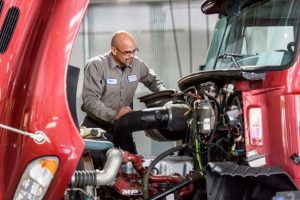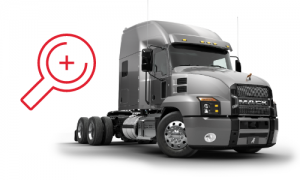
The Commercial Vehicle Safety Administration (CVSA) International Roadcheck will take place May 4-6, 2021. Over that 72 hour period, commercial motor vehicle inspectors in jurisdictions throughout North America will conduct inspections on commercial motor vehicles and drivers. During the Roadcheck, inspectors will primarily conduct the North American Standard Level I Inspection, a 37-step procedure that includes two main inspection categories: driver operating requirements and vehicle mechanical fitness. This year, inspectors will be focusing on hours of service and lighting. Let’s discuss some of the key aspects of the 2021 CVSA International Roadcheck, and how Bergey’s Truck Centers can help you pass with flying colors!

May drive a maximum of 11 hours after 10 consecutive hours off duty.
May not drive beyond the 14th consecutive hour after coming on duty, following 10 consecutive hours off duty. Off-duty time does not extend the 14-hour period.
Drivers must take a 30-minute break when they have driven for a period of 8 cumulative hours without at least a 30-minute interruption. The break may be satisfied by any non-driving period of 30 consecutive minutes (i.e., on-duty not driving, off-duty, sleeper berth, or any combination of these taken consecutively).
May not drive after 60/70 hours on duty in 7/8 consecutive days. A driver may restart a 7/8 consecutive day period after taking 34 or more consecutive hours off duty.
Drivers may split their required 10-hour off-duty period, as long as one off-duty period (whether in or out of the sleeper berth) is at least 2 hours long and the other involves at least 7 consecutive hours spent in the sleeper berth. All sleeper berth pairings MUST add up to at least 10 hours. When used together, neither time period counts against the maximum 14- hour driving window.
Drivers are allowed to extend the 11-hour maximum driving limit and 14-hour driving window by up to 2 hours when adverse driving conditions are encountered.
A driver is exempt from the requirements of §395.8 and §395.11 if: the driver operates within a 150 air-mile radius of the normal work reporting location, and the driver does not exceed a maximum duty period of 14 hours. Drivers using the short-haul exception in §395.1(e)(1) must report and return to the normal work reporting location within 14 consecutive hours, and stay within a 150 air-mile radius of the work reporting location.
May drive a maximum of 10 hours after 8 consecutive hours off duty.
May not drive after having been on duty for 15 hours, following 8 consecutive hours off duty. Off-duty time is not included in the 15-hour period.
May not drive after 60/70 hours on duty in 7/8 consecutive days.
Drivers using a sleeper berth must take at least 8 hours in the sleeper berth, and may split the sleeper berth time into two periods provided neither is less than 2 hours. All sleeper berth pairings MUST add up to at least 10 hours.
Drivers are allowed to extend the 10-hour maximum driving time and 15-hour on-duty limit by up to 2 hours when adverse driving conditions are encountered.
A driver is exempt from the requirements of §395.8 and §395.11 if: the driver operates within a 150 air-mile radius of the normal work reporting location, and the driver does not exceed a maximum duty period of 14 hours. Drivers using the short-haul exception in §395.1(e)(1) must report and return to the normal work reporting location within 14 consecutive hours, and stay within a 150 air-mile radius of the work reporting location.
Incandescent Roadside Repair Kit #97382B

04/01/2021 thru 05/31/21
Did you know that in 2020 there were 335,778 vehicle violations issued due to inoperable required lamps resulting in 25,430 out of service violations?
The top vehicle violation in the U.S. in 2020 was inoperable required lamp, accounting for 12.2% of all vehicle violations and 4.4% of all out-of-service vehicle violations. Taking into account all possible lighting-related violations issued in 2020, one in four vehicles chosen for inspection (25.3%) was issued a lighting-related violation. Slightly more than one in seven out-of-service violations (16.4%) in the U.S. was lighting related.
Bergey’s Truck Centers’ Parts Departments now offers an incandescent roadside repair kit with genuine Truck-Lite™ components, including 10, 19 & 30 Series marker clearance lights in red and yellow, a 40 Series Stop/Turn/Tail light, grommets, bracket mount, plugs, splices and crimping tool. Conveniently storable in a heavy-duty vinyl bag, drivers now have an option to avoid risking lighting violations while out on the road.
That’s quite a list! To make sure that you are in compliance, get your Rig ready for the CVSA International Roadcheck by taking advantage of our DOT Inspection Special at our Service Departments. Our factory trained technicians will inspect the following:


(Offer Valid April 1st – 30th, 2021. By Appointment Only, Certain Restrictions Apply)

Posted by: